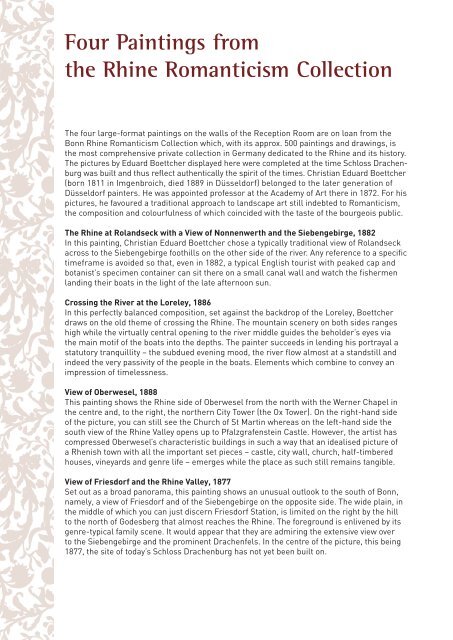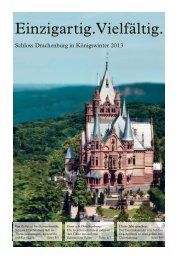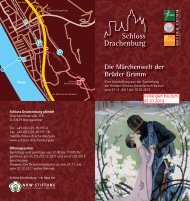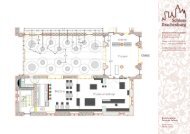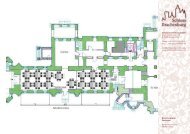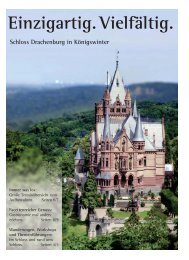North Tower - Schloss Drachenburg
North Tower - Schloss Drachenburg
North Tower - Schloss Drachenburg
You also want an ePaper? Increase the reach of your titles
YUMPU automatically turns print PDFs into web optimized ePapers that Google loves.
Four Paintings from<br />
the Rhine Romanticism Collection<br />
The four large-format paintings on the walls of the Reception Room are on loan from the<br />
Bonn Rhine Romanticism Collection which, with its approx. 500 paintings and drawings, is<br />
the most comprehensive private collection in Germany dedicated to the Rhine and its history.<br />
The pictures by Eduard Boettcher displayed here were completed at the time <strong>Schloss</strong> <strong>Drachenburg</strong><br />
was built and thus refl ect authentically the spirit of the times. Christian Eduard Boettcher<br />
(born 1811 in Imgenbroich, died 1889 in Düsseldorf) belonged to the later generation of<br />
Düsseldorf painters. He was appointed professor at the Academy of Art there in 1872. For his<br />
pictures, he favoured a traditional approach to landscape art still indebted to Romanticism,<br />
the composition and colourfulness of which coincided with the taste of the bourgeois public.<br />
The Rhine at Rolandseck with a View of Nonnenwerth and the Siebengebirge, 1882<br />
In this painting, Christian Eduard Boettcher chose a typically traditional view of Rolandseck<br />
across to the Siebengebirge foothills on the other side of the river. Any reference to a specifi c<br />
timeframe is avoided so that, even in 1882, a typical English tourist with peaked cap and<br />
botanist’s specimen container can sit there on a small canal wall and watch the fi shermen<br />
landing their boats in the light of the late afternoon sun.<br />
Crossing the River at the Loreley, 1886<br />
In this perfectly balanced composition, set against the backdrop of the Loreley, Boettcher<br />
draws on the old theme of crossing the Rhine. The mountain scenery on both sides ranges<br />
high while the virtually central opening to the river middle guides the beholder’s eyes via<br />
the main motif of the boats into the depths. The painter succeeds in lending his portrayal a<br />
statutory tranquillity – the subdued evening mood, the river fl ow almost at a standstill and<br />
indeed the very passivity of the people in the boats. Elements which combine to convey an<br />
impression of timelessness.<br />
View of Oberwesel, 1888<br />
This painting shows the Rhine side of Oberwesel from the north with the Werner Chapel in<br />
the centre and, to the right, the northern City <strong>Tower</strong> (the Ox <strong>Tower</strong>). On the right-hand side<br />
of the picture, you can still see the Church of St Martin whereas on the left-hand side the<br />
south view of the Rhine Valley opens up to Pfalzgrafenstein Castle. However, the artist has<br />
compressed Oberwesel’s characteristic buildings in such a way that an idealised picture of<br />
a Rhenish town with all the important set pieces – castle, city wall, church, half-timbered<br />
houses, vineyards and genre life – emerges while the place as such still remains tangible.<br />
View of Friesdorf and the Rhine Valley, 1877<br />
Set out as a broad panorama, this painting shows an unusual outlook to the south of Bonn,<br />
namely, a view of Friesdorf and of the Siebengebirge on the opposite side. The wide plain, in<br />
the middle of which you can just discern Friesdorf Station, is limited on the right by the hill<br />
to the north of Godesberg that almost reaches the Rhine. The foreground is enlivened by its<br />
genre-typical family scene. It would appear that they are admiring the extensive view over<br />
to the Siebengebirge and the prominent Drachenfels. In the centre of the picture, this being<br />
1877, the site of today’s <strong>Schloss</strong> <strong>Drachenburg</strong> has not yet been built on.


